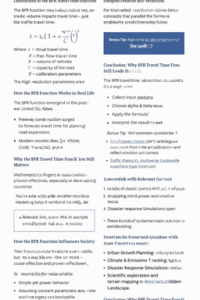Ever wondered how traffic planners predict delays with uncanny accuracy—even decades into the future? The answer lies in a powerful equation known as the BPR travel time function. Developed by the U.S. Bureau of Public Roads, this model transforms simple data—like traffic volume and road capacity—into precise predictions about how long it will take to get from point A to B.
But this isn’t just a dry math formula buried in planning documents. The BPR travel time function is the hidden engine behind traffic simulations, smart city blueprints, highway expansions, and even emergency evacuation strategies. With it, cities simulate rush hours before roads are built, optimize routes for public transit, and prevent gridlock years before it starts.
In this definitive guide, we’ll walk you through the science behind the formula, its historical evolution, and real-world applications that touch every corner of urban life. But we won’t stop there. We’ll also show how its logic—inputs, delays, consequences—mirrors the twists and turns of comic-inspired sci-fi storytelling. Whether you’re analyzing highway congestion or writing about characters navigating multiverse traffic, the patterns are surprisingly similar.
Traffic Planning Snapshot
| Factor | Description |
| BPR Function Use | Estimates travel time based on traffic volume |
| Core Variables | Free-flow time, capacity, and actual volume |
| Primary Applications | Urban planning, simulations, congestion analysis |
| Data Sources | GPS, sensors, traffic surveys |
| Influence on Pop Culture | Shows up in dystopias, simulations, and web fiction |
What Is the BPR Travel Time Function?
The BPR travel time function is a fundamental equation in transportation modeling. Originally developed by the U.S. Bureau of Public Roads in the 1960s, it estimates how traffic volume impacts travel time on a given road segment. The classic formula looks like this:

Where:
- ttt: actual travel time
- t0t_0t0: free-flow travel time (no congestion)
- VVV: volume of vehicles
- CCC: capacity of the road
- α,β\alpha, \betaα,β: calibration parameters (typically 0.15 and 4)
In simple terms, as traffic volume approaches or exceeds capacity, travel time increases sharply.
How the BPR Function Works in Real Life
In practice, planners plug this equation into simulation tools to forecast:
- Peak-hour delays
- Toll road efficiency
- Effects of new infrastructure
- Emergency evacuation timelines
For instance, if you’re building a new bypass or adding lanes to a highway, the BPR travel time function lets you model how those changes will affect commute time—without waiting decades to test them. This concept of forecasting and speculative modeling is central to the storytelling style in Time Locker, where characters face shifting timelines and unpredictable outcomes much like traffic patterns do in real-world simulations.

Origins: The Birth of the BPR Model
The BPR function emerged in the post-war United States, when freeway construction surged, and traffic congestion became a national concern. The U.S. Bureau of Public Roads (now FHWA) needed a reliable way to predict travel time for planning road expansions. Hence, the function was born, becoming part of the Highway Capacity Manual and later travel demand models.
In its early days, the formula was revolutionary. Today, it still anchors complex simulation tools like:
- VISUM
- CUBE
- TransCAD
- Aimsun
Why the BPR Travel Time Function Still Matters
Though over 60 years old, the BPR travel time function remains crucial. Why?
- Simple yet powerful: It uses easy-to-collect data but gives reliable estimates.
- Scalable: Works on single streets or entire metro areas.
- Customizable: Parameters can be tuned for local conditions.
It’s especially popular in developing countries where large-scale models aren’t feasible.
Mathematics Meets Sci-Fi: Predicting the Future
In futuristic comics and digital fiction, the idea of “time” is often bent by external variables—just like travel time in the BPR formula is influenced by volume and capacity. If you enjoy narratives that explore similar cause-and-effect systems, check out:
Traveling Through Time and Space to Become an Unlucky NPC—a brilliant example of how subtle environmental factors can reshape one’s journey.
Limitations of the BPR Travel Time Function
Despite its strengths, this model isn’t perfect. Critics argue:
- It oversimplifies driver behavior.
- It assumes constant parameters across time and space.
- It doesn’t account for shockwaves or adaptive routing.
Modern models like the Akçelik function or microsimulation tools often supplement or replace BPR in advanced applications.
Still, BPR is unbeatable for strategic planning, especially when resources are tight.
BPR in Pop Culture and Conceptual Design
Though rarely named directly, the BPR travel time function influences creative worldbuilding:
- Dystopian cities with gridlock chaos
- Time-looping characters facing shifting paths
- Futuristic societies optimized by hyper-logic transport rules
Umineko Time Travel dives into fragmented timelines and logic-driven storytelling—concepts that parallel the predictive structure of the BPR model.
BPR in Smart City and AI Applications
The rise of AI in transportation means the BPR model is more relevant than ever:
- Machine learning uses BPR to calibrate predictions.
- Smart traffic lights adapt based on modeled travel time.
- Autonomous vehicles use similar logic to reroute in real time.
This synergy of data + theory creates “living cities” where roads are dynamic rather than static.
Want to understand how structured systems guide creativity? Check out SpaceBattles Creative Writing, where fanfiction authors simulate branching timelines just like traffic models do.
How to Use the BPR Function: A How-to Guide
Ready to model traffic flow like a transportation expert? Using the BPR travel time function may sound complex, but with the right data and tools, anyone from city planners to advanced students can use it to simulate congestion and estimate realistic travel times. Here’s a breakdown of how to apply the formula in real-world planning or academic scenarios.
1. Collect Input Data
Before you can use the BPR equation, you’ll need to gather some basic traffic information for each road segment you’re analyzing:
- Free-flow speed: This is the speed vehicles would travel at if there were no congestion—usually during off-peak hours. You can measure it using GPS data or refer to standard values for your road type.
- Segment length: Measure the length of the road section in kilometers or miles. This helps calculate the base (free-flow) travel time.
- Traffic volume (V): Count how many vehicles typically use the road in a given time frame (e.g., per hour). Traffic sensors, cameras, or surveys are common data sources.
- Road capacity (C): Estimate the maximum number of vehicles the road can handle per hour before congestion starts. This varies by design, lane count, and environment.
The more accurate your input data, the more reliable your predictions will be—just like crafting a believable storyline in a fictional world.
2. Choose Alpha (α) & Beta (β) Values
These two constants control how aggressively travel time increases as volume nears capacity. The most commonly used values are:
- Default values:
- α = 0.15
- β = 4
- Customized calibration:
You can tweak these values to reflect real-world data from your city or region. Some studies use α = 0.20 or β = 3.5, depending on local traffic behavior.
Remember: α controls the sensitivity to congestion, while β shapes how sharply delays increase once capacity is exceeded.
3. Apply the BPR Formula
Once your data is ready, plug everything into the formula:
Where:
- t0t_0t0 = Free-flow travel time
- VVV = Volume of vehicles
- CCC = Road capacity
- α\alphaα, β\betaβ = Model constants
- ttt = Predicted travel time
Tools you can use:
- Excel: Great for small networks or single-segment studies
- Python or R: Perfect for automating calculations across a large network
- GIS/Modeling software: Tools like TransCAD, VISUM, or CUBE integrate BPR into traffic simulation models
4. Interpret the Results
Once you’ve calculated travel times for each segment, it’s time to understand what they mean:
- Spot congestion trends: Compare predicted times with free-flow conditions to identify problem areas.
- Plan upgrades: Use this info to test the impact of adding lanes, creating alternate routes, or changing traffic signal timing.
- Evaluate scenarios: Run the model under different volumes (e.g., peak vs. off-peak) to see how traffic behaves over time.
Curious how alternate timelines play out in fiction? Our article on Time Travel Dress to Impress explores how comic creators use shifting aesthetics to reflect emotional journeys—just like how changing road variables reflect real-world traffic shifts.
How the BPR Function Influences Society
1. Urban Growth Planning
Cities like Singapore and Toronto use the function to control development and manage housing-to-job ratios.
2. Climate & Emissions Tracking
Longer travel times = higher emissions. Using BPR helps estimate CO₂ impacts and supports green policy.
3. Disaster Response Simulations
Emergency evacuation models rely on it to simulate movement under stress.
These kinds of systemic maps are also explored in speculative art and storytelling—like in Comic Book Movement, which discusses how new ideas disrupt old systems.
- Historic female figures in transportation are under-discussed. But the Girl of Classic Comics NYT article gives cultural context to early contributions by women in media and policy.
- Analyzing mind-power and creative focus, especially when stuck in traffic, takes center stage in NetworkFinds: How HHC Affects Creativity.
- Traffic theory vs. multiverse design can feel oddly similar. Superhero Hype and its forums explore narrative planning in genre fiction—just like transportation planners map storylines of mobility.
- Scientific exploration and terrain mapping also rely on digital modeling like BPR. Dive into Antarctica’s Hidden Landscape to see this logic applied in geography.
Conclusion:
The BPR travel time function may be decades old, but its simplicity, adaptability, and proven effectiveness keep it relevant in today’s high-tech world. Whether you’re managing city traffic or writing time-bending web fiction, this formula shows how inputs shape outcomes—and how even small variables can lead to massive change.
For readers who love data, decision-making, and multiverse thinking, this model offers a concrete framework for understanding the abstract: the flow of time itself.
FAQs:
What is the BPR travel time function used for?
It’s used to estimate travel time on roadways based on traffic volume and road capacity.
Who developed the BPR travel time function?
The U.S. Bureau of Public Roads (now FHWA) introduced it in the 1960s.
Is the BPR model still used today?
Yes, it’s a standard tool in transportation planning worldwide.
What are α and β in the BPR formula?
They are calibration constants, usually set to 0.15 and 4 but can be customized.
Can I use the BPR function in Excel?
Absolutely. Many engineers use spreadsheets or Python to calculate travel time using this model.
How is it different from real-time GPS estimates?
GPS gives live data, while BPR offers predictive modeling for future conditions.
Is the BPR travel time function used in simulation software?
Yes. It powers tools like VISUM, TransCAD, and Aimsun.
What industries rely on this model?
Urban planning, logistics, environmental science, and even emergency response.
Does BPR account for pedestrian or bike traffic?
Not directly—it’s vehicle-specific, though it can be adapted for multimodal studies.
Where can I learn more about traffic, time, and timelines?
Check out Comics Vanguard for genre-bending articles that connect science, fiction, and creative storytelling.


After I originally commented I clicked the -Notify me when new feedback are added- checkbox and now every time a remark is added I get 4 emails with the identical comment. Is there any means you can take away me from that service? Thanks!
I’ll immediately grab your rss feed as I can’t find your email subscription link or e-newsletter service. Do you have any? Kindly let me know so that I could subscribe. Thanks.
Thank you for the auspicious writeup. It in fact was a amusement account it. Look advanced to more added agreeable from you! By the way, how can we communicate?
You have observed very interesting details! ps nice web site. “Never take the advice of someone who has not had your kind of trouble.” by Sydney J. Harris.
Great web site. Lots of useful information here. I am sending it to some friends ans also sharing in delicious. And obviously, thanks for your sweat!
I real happy to find this internet site on bing, just what I was searching for : D likewise saved to favorites.
There is noticeably a bundle to learn about this. I assume you made certain good factors in features also.
Hi my family member! I wish to say that this article is awesome, great written and include almost all important infos. I would like to see extra posts like this .
Wow! This can be one particular of the most helpful blogs We’ve ever arrive across on this subject. Actually Excellent. I am also a specialist in this topic so I can understand your effort.
Good write-up, I am normal visitor of one?¦s web site, maintain up the nice operate, and It’s going to be a regular visitor for a lengthy time.
Excellent weblog right here! Also your web site so much up fast! What host are you the usage of? Can I get your affiliate link to your host? I wish my web site loaded up as quickly as yours lol
I like this weblog its a master peace ! Glad I observed this on google .
I’d perpetually want to be update on new content on this site, bookmarked! .
I’m not sure where you’re getting your information, but great topic. I needs to spend some time learning more or understanding more. Thanks for excellent info I was looking for this info for my mission.
Betpontobet1… mmm not a name I know too well. But the welcome offers look slick and competitive when I checked it briefly, Worth taking a second look if you want some extra juice: betpontobet1